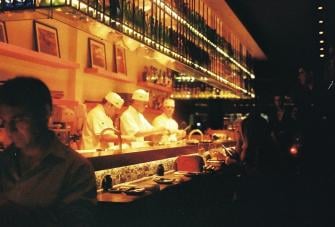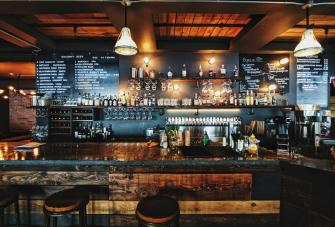Red flags when buying a restaurant: A guide for business owners
Ah, the allure of owning a restaurant! 🍽️ Picture this: a bustling dining area, the clink of glasses during a toast, and the satisfied smiles of customers savoring your establishment's signature dish. For many, owning a restaurant is the embodiment of a dream. It’s a space where culinary passion meets entrepreneurship, a blend of creativity and commerce.
However, just as with any fairytale, there's always a backstory. While the idea of buying a restaurant can be deeply enticing, it's essential to approach the decision with both eyes wide open. The restaurant industry, for all its flavors and flair, can be fraught with subtle pitfalls for the unwary investor. That's why the mantra for potential first restaurant buyers should always be: "Due diligence process first, celebration later." 🎉
As you embark on this exciting journey towards restaurant ownership, let's explore some common red flags. Being aware of these potential issues will not only save you headaches (and perhaps a significant amount of your cash flow) but also help ensure that your restaurant story has a happy ending.
Ready to dive in? Let's get started.
Red flag #1: Restaurant business valuation (Don't overpay!) 🏷️
Let’s talk numbers. When you’re eyeing a restaurant to buy, one of the first things you'll likely look at is its valuation. But here's a pro tip: not every price tag reflects the actual restaurant's assets and value. Sometimes, in the heat of the dream, we might overlook key indicators, and that's precisely where red flags when buying a restaurant start waving.
So, how can you tell if that restaurant you've got your heart set on might just be overpriced?
For starters, understanding a fair market value is crucial. Think of it as shopping for a car. 🚗 You wouldn’t pay a brand-new price for a used car with high mileage, right? Similarly, a restaurant’s value should be based on factors like its current earnings, assets, location, and more.
But here's where things can get tricky. Some restaurant owners or sellers might inflate their existing restaurant's profit margins or sales tax and downplay expenses to make the valuation seem more appealing. It’s like adding a few extra layers of icing on a cake to hide the fact that it’s stale underneath. 🍰
The bottom line? Always dig deep. Ask for detailed financial statements, consult with industry experts and professionals, and trust your gut. Remember, buying a restaurant is as much a business move as it is a passion project. So, while it’s okay to fall in love with the place, make sure you’re also getting a fair deal.
Red flag #2. Navigating the slippery slope of declining sales trends 📉
Let’s chat about something that’s as essential as the seasoning in our favorite dishes: restaurant sales trends. 📊
Now, you might have come across a restaurant that looks aesthetically pleasing, has a charming vibe, and even boasts a menu that makes your mouth water. But if its sales charts are more downhill than a winter sled ride, you might have a problem on your hands.
We get it; it's tempting to think, "Oh, the current restaurant owner just didn’t market it right," or "I've got fresh ideas that will totally turn things around!" Optimism is great, but it's crucial to pair it with realism.
So, why should declining sales trends raise eyebrows? Well, it's kind of like seeing dark clouds on the horizon. Sure, it might just be a light drizzle, or you could be in for a full-blown storm. Declining sales over several years can indicate deeper issues like deteriorating customer loyalty, increasing competition, or even changing neighborhood demographics.
And let’s face it: reversing a downward trend isn't as simple as flipping a switch. It requires strategy, effort, resources, and time. While bringing a restaurant back to its glory days is possible, you should be prepared for the uphill climb. Ask for the reasons for the trend and the data to make up the reasons (if they have it) - if not, you may need to do some digging before signing on the dotted line.As you ponder over those sales graphs, just ensure you're going in fully informed and with a robust plan in place.
Top tip: With a restaurant POS system, you can track easily menu items performance based on sales volume and time periods as part of your operations management.
Red flag #3. Decoding online reviews: The good, the bad, and the ugly 🌐👎
Now that we've delved into the intricacies of existing restaurant valuations and sales trends, let’s take a look at the digital - into the world of online reviews. In today's uber-connected age, most of us won’t even order a pair of socks without glancing at the reviews first, let alone the purchase price of a place to dine!
So, you've found a restaurant you're considering buying. It's got charm, a fabulous location, and the menu. Chef's kiss! 😘 But then, you take a stroll down the review lane and stumble upon a barrage of negative comments. Uh-oh! Red alert? 🚨
Here's the thing: a restaurant's online reputation can be a crystal ball into its past. While a few negative reviews are expected (let’s face it, you can’t please everyone!), a consistent pattern of unhappy customers can hint at deeper operational or quality issues. And here's a slightly bitter pill to swallow: even if you change things after buying, those reviews and the reputation will linger, casting shadows on your revamped venture.
Think of online reviews as the tattoos of the digital world. Some are beautiful, telling heartwarming tales, while others... not so much. And just like tattoos, they’re tough to erase.
But don’t lose hope! If your heart's set on a particular place, consider this as an opportunity. Engage with past reviewers, understand their concerns, and let them know that change is on the horizon. It's all about building bridges and mending fences when it comes to handling customers’ complaints. Find out what made patrons so unhappy and make sure you have the plan to fix it - whether that's retraining staff and hiring specialists, or updating the decor. Similarly, if you have the budget, consider the benefits of a full or partial rebrand with your new restaurant ownership.
However, the key takeaway? Always, and we mean ALWAYS, take a deep dive into a restaurant's online presence. Because in this age, the virtual world can heavily influence the restaurant marketing real one.
Red flag #4. Is that restaurant's equipment vintage or just outdated? The tell-tale signs in equipment and décor 🛠️🚫
Picture this: you walk into a potential buy, and the place has that rustic charm, a little vintage aesthetic, maybe even that retro jukebox in the corner. But wait a minute – is that a charming choice, or is the place just... old?
Here's a simple truth: while vintage vibes can be a massive hit, outdated equipment and worn-out décor can be a massive drain on your wallet. That ancient-looking oven? It might be consuming double the energy of modern counterparts. And those ‘retro’ chairs? They might be a sneeze away from falling apart. 🪑💥
Sometimes, the line between "vintage chic" and "just old" can be razor-thin. That’s why it’s crucial to discern if the restaurant you're eyeing is intentionally rustic or unintentionally falling apart. The best way to do this is by going in person and knowing your stuff on restaurant and kitchen equipment!
And let’s have some real talk: Customers today aren't just paying for food. They're paying for a dining restaurant experience. A dining space that looks and feels outdated can be a natural mood killer, no matter how delicious the food is.
But on the flip side, there’s a silver lining here! If you've got the vision (and budget) for it, an outdated space can be your canvas. A little revamp, some new restaurant equipment, and a touch of modern magic, and voila! You've got yourself a transformed, buzzing hotspot. Plus, remember that you can look to rent more modern kitchen equipment to help keep costs lower until you can fork out for a full purchase of the latest equipment. 🔥
However, if the renovation costs might burn a hole in your pocket, it could be a sign to proceed with caution or look elsewhere.
Remember, in the world of restaurants, ambiance and efficiency go hand in hand. So, while you're dreaming of that perfect space, ensure both these pals are on your side.
Red flag #5. Red flags in lease and agreements: Navigating restaurant rental pitfalls 📑🔍
As we continue our adventure into restaurant ownership, let's talk about something a tad less glamorous but oh-so-crucial: leases and rental agreements. Because, believe it or not, the success of your culinary venture might just be hiding in the fine print.
Ever heard the saying, "Location, location, location"? While that’s undeniably vital, we'd add, "Lease, lease, lease!" to that list. The terms of your lease can spell the difference between a thriving eatery and a financial fiasco.
So, you’re considering buying this fantastic restaurant, and the current owner hands you the lease agreement. At first glance, everything seems in order. But here’s what your inner detective needs to look out for:
- Unexpected rent hikes are on the horizon
- Hidden charges (such as cancellation fees)
- Is the lease almost up with no option for renewal?
See, one of the major red flags when buying a restaurant is a shaky agreement. Imagine putting your heart, soul, and savings into revamping a place, only to find out you might have to relocate in a year. Ouch, right? So, learn all about finding the right space for your restaurant lease agreement and avoid surprises along the way!
Don’t forget the landlord
Moreover, let's not forget about the relationship with the landlord. A supportive landlord can be a silent partner in your success, while a tricky one can make things, well, tricky. It's a bit like a dance, and you definitely want a partner who's in rhythm with you. 💃🕺
In conclusion, before signing on that dotted line, ensure you're not just renting a space but securing a future. Dive deep into that lease, maybe even get a legal eagle 🦅 (read: lawyer) to peek through, and ensure your dream restaurant isn’t built on shifting sands.
Red flag #6. Financial fog or clear horizon? Unmasking inconsistent financial records 📊❓
It’s time to talk about a topic that might seem a bit daunting but is super essential: financial records. Think of them as the heartbeat monitor for any successful business. They give you an instantaneous look at the health, vitality, and, dare we say, the very soul of a restaurant.
Now, we get it. Not all of us are number-crunching aficionados. But when it comes to buying a restaurant, those numbers can tell tales – both enchanting fairy tales and grim horror stories.
Stumbling upon inconsistent financial records can be like finding a plot twist in your favorite novel. Suddenly, the storyline doesn't make sense. Why are there missing months of data? Why do the expenses look like they’re on a roller coaster ride? And what’s the reason behind a sudden, unexplained spike in revenue?
See, in the restaurant business, consistency is more than just about the food. It's about trust. When records seem haphazard or dubious, it can indicate underlying issues. Maybe there were periods of underreported sales or perhaps some significant expenses were conveniently 'forgotten'.
But here's the good news: This is your Sherlock moment. Arm yourself with questions. Consult with financial experts or accountants who specialize in the hospitality sector and don't forget about asking restaurant investors!!
Finally, most importantly, trust your gut. If something feels off, chances are, there's more beneath the surface.
Remember, when diving into the world of restaurant ownership, you want to swim in clear waters, not murky depths. So, ensure those financial records shine a clear path ahead, not leave you lost in the fog.
Take Control with a Responsive Restaurant POS
Host with confidence when you rely on Epos Now’s dedicated restaurant POS. Process multichannel sales (from in-house, takeaway, and delivery) all in one place!
Red flag #7. The human element: Unraveling employee relations and morale 🤝💔
While interiors, finances, and leases are undeniably crucial, let’s delve into something a tad more intangible but deeply significant: the human element. After all, a restaurant is more than just its walls and dishes – it's a symphony of people, from the chefs behind the curtain to the servers on the floor.
Ever walked into a place and felt an unmistakable vibe? Maybe it's warmth, maybe it's tension, or perhaps it’s a palpable enthusiasm. That, my friend, is the pulse of the restaurant's team. And when you're thinking of taking the reins, understanding this pulse can be invaluable.
So, why the focus on employee relations and morale? Even if you’ve found a restaurant with great potential, there may be an unmistakable cloud of low morale. Employees seem disengaged, there’s a high staff turnover, or maybe you've heard whispers of unresolved disputes. Such signs can be major, red flag when buying a restaurant. 🚩
Here’s the real tea: a demotivated team can be a symptom of deeper issues. Maybe there's a history of poor management, lack of growth opportunities, or even unresolved conflicts. And while you might think, "I'll be a different kind of owner," remember that past issues can linger, casting shadows on your new journey.
But, as with every challenge, there's an opportunity. Engage in candid conversations with the staff. Understand their concerns, dreams, and hopes for the place. Not only will this give you invaluable insights, but it'll also pave the way for a brighter, more harmonious future. 🌈
Top tip: Read our blog about how to foster a great restaurant culture for your employees
In the end, remember that while dishes, décor, and data are pivotal, it's the people that add the real flavor to a restaurant. So, before taking the plunge, ensure the human element is on your side, cheering you on!
Red flag #8. The sneaky pitfall of insufficient due diligence 🧐🚫
Here’s a quick heads up: A hasty deal without comprehensive due diligence can spell unforeseen challenges. Maybe there's undisclosed debt. Or perhaps there are unresolved legal disputes that could come back to haunt you. Yikes!
The key takeaway? Always be curious and inquisitive. Dive deep, ask questions, and don't be afraid to unearth every nook and cranny. Remember, when it comes to your dream restaurant, it's better to be over-prepared than caught off guard. Your future self will definitely thank you! 🙌
Not all red flags are created equal
Well, culinary conqueror, we've taken quite the journey together, haven't we? From dissecting the nuances of leases to diving deep into financial records and understanding the heartbeats of teams, we've navigated the multifaceted world of buying a restaurant.
Remember, every successful restaurateur has one thing in common: they didn’t just dive in blindly; they equipped themselves with knowledge and intuition. As you stand on the precipice of this exciting venture, ensure you heed the red flags and harness the golden opportunities. Your dream restaurant awaits, not just as a space but as a story waiting to be told. Here’s to crafting yours with insight, passion, and a sprinkle of culinary magic! 🍾🎉
Ready to embark on your restaurant journey with confidence? 🍽️✨ Fill in the form below to receive personalized tips and insights tailored just for you! Don't miss out; your culinary success story is just a click away. 🚀




